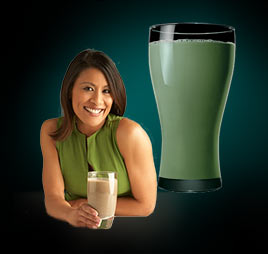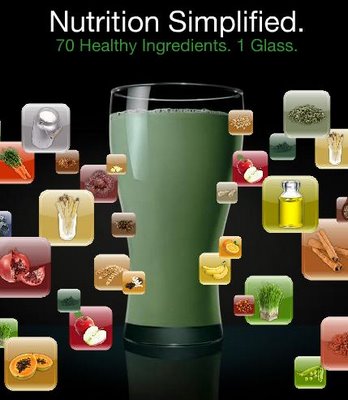Shakeology was featured in the May 2011 issue of Oprah’s “O” magazine. Shakeology’s creator and “O”‘s editor and chief travel to Peru experience some super foods that just might change your life.
Below is the actual article from the magazine which can be found in “O” by Susan Casey.
Around 4 o’clock on any given morning, Darin Olien will walk into his Malibu, California, kitchen and make himself a smoothie. This will not be an ordinary drink. The other day, for example, he tossed the following into his blender: coconut water, fermented sprouted brown rice, maca, aloe vera juice, barley grass powder, kamut juice powder, almond butter, camu camu, avocado, goji, lucuma powder, noni juice, cacao nibs, MSM, maqui, bee pollen, sacha inchi oil, omega-3-DHA/EPA oil, Hawaiian deepwater salt, chia seeds, nopal, goat yogurt, luo han guo, and a powder called Shakeology.
If you’ve never heard of many of these ingredients, you’re not alone. But stay with me here, because they’re among the most powerful nutrients on Earth. Olien’s specialty is what’s known as “formulating,” taking wildly beneficial substances and combining them into something even more potent: a supplement, a snack, a tea, a medicine, a smoothie. Every food in nature contains a mix of proteins, fats, and carbohydrates, along with noncaloric vitamins, minerals, fibers-all of which fuel our cells-and each one has unique abilities that we really don’t understand, but it is now clear that some foods pack an extra biochemical punch. Camu camu fruit, for instance, provides the richest source of vitamin C known to exist. Maca, a hearty root that grows only in the high Andes, comes in yellow, red, and black varieties, boosts fertility, is said to balance hormones, and dispenses a day’s worth of kick-ass energy. Sacha inchi is another South American treasure, a protein-rich, metabolism-revving nut that delivers an omega-3 bonanza. Olien’s final ingredient, Shakeology, contains more than 70 components itself, a crazy cornucopia of good.
No one understands Shakeology better than Olien, who created it in 2008, after Carl Daikeler, CEO of the fitness company Beachbody, challenged him to come up with a supplement to match the tagline The Healthiest Meal of the Day. His customer was someone who wanted optimum wellness, wanted to lose weight, wanted cholesterol levels to drop-but had no intention of eating a platter of broccoli each day. Daikeler gave Olien no limits on quality, no cost/revenue restrictions; the goal was to shoot the moon, to seek out and combine the most extraordinary plants, fruits, nuts, herbs-nature’s secret weapons. And Olien found them: ashwagandha from China, cordyceps from Bhutan, yacon from Peru. An alphabet of vitamins and minerals from the purest sources. Prebiotics. Probiotics. Green tea and grapeseed extracts, chlorella and spirulina and hydrilla, a spectrum of enzymes. Since hitting the market in March 2009, more than 400,000 bags of Shakeology, at $119.95 each, have been sold.
Olien himself is a strapping guy, north of six feet and solid. He looks, in fact, like the steak-fed Midwestern varsity football player that he was, until a back injury derailed his athletic career. From that low point Olien had tried to rehabilitate himself using traditional methods-lots of animal protein, relentless physiotherapy-but it was only when he adopted a radically new diet of superfoods that he was able to regain his strength. This not only improved his health, it revealed his calling. “It was one of the greatest turns in my life,” Olien says, “because it got me into the question, ‘What can I do to fix this?’ I became very curious about the body, switched my major to exercise physiology and nutrition. Then I healed myself.” Over the years he also managed to help many others with their diet and fitness regimens, and Olien’s “concoctions,” his powders and bars and health innovations, began to attract attention.
On the first morning I met Olien I watched him doing squat jumps holding 40-pound weights, while holding his breath underwater. Another workout he likes to do involves harnessing himself to a 150-pound railroad tie and dragging it through thick sand. Whatever he eats needs to fuel these exploits, so people are often surprised to hear that his diet consists mostly of plants. Olien consumes no processed foods, no polysyllabic ingredients invented in labs, no high-fructose corn syrup or trans fats, no artificial flavorings, no antibiotic-laced dairy products, nothing that comes out of a drive-thru. In short, he doesn’t eat what’s generally on offer in the modern food world. “When people find out that I don’t eat this or I don’t eat that, I feel a sense of pity coming from them,” he says, “and I think, ‘Wow! You have no idea. I’m not deprived at all. Come to my kitchen! I’ll blow your mind.’”
Thing is, science is now catching up to something that nature has known all along: the rich greens, the vibrant yellows, the deep indigos of plants are key to our well-being. That meat we love so much? Proven to clog our arteries. Convenience foods-heavily sweetened and salted, laden with fat and chemicals-wreak havoc on everything from our immune systems to our moods to our weight. Here are the facts and they’re not very pretty: Americans are the fattest people ever in history. Obesity, a body composition topping 30 percent fat, is the most pressing health crisis we face, with 34 percent of the adult population falling into that category (plus 29 percent of all children). If you add in the merely overweight it’s closer to 68 percent. In the past 50 years the weight of the typical American citizen has increased, on average, by 25 pounds. If we continue at this rate, by 2050 every last person will have eaten himself into the danger zone.
“Every time you eat processed foods, you exclude from your diet not only the essential nutrients that we are aware of, but hundreds of other undiscovered phytonutrients that are crucial for normal human function,” Joel Fuhrman, MD, writes in his new book, Eat to Live: The Amazing Nutrient-Rich Program for Fast and Sustained Weight Loss, which stresses the importance of a diet full of high-quality produce. Mehmet Oz, MD, who wrote the foreword to Fuhrman’s book, believes that even a slight shift away from meat can improve your health. “What we really want to do is have people nudge themselves in the right direction,” he told me. “If you want to have a few bacon bits on your salad, God bless you, fine. That’s not where we’re losing the battle. We’re losing the battle when you have sausage for breakfast, a big pastrami sandwich for lunch, and pork chops for dinner.”
Yet we live in a mass-produced, big-box culture, where economic interests hold sway. Meat, corn, sugar-they come cheap, and we buy them. Plus, we tend to like the taste. But there are steep hidden costs in a food system that makes calories rather than nutrients-from the factory farms that treat animals like parts on an assembly line to the fact that obesity-related ailments like heart disease, stroke, and diabetes are skyrocketing and account for approximately $150 billion in healthcare expenses each year.
As both Fuhrman and Oz would attest, anyone consuming a steady diet of man-made edibles would benefit even from something as prosaic as lettuce, but far more intriguing foods exist. As Olien began to talk about the vegetables, fruits, grains, herbs, and other plants he was hunting, I realized there was an entire universe out there I didn’t know about. I had never heard of lucuma or sapote or aguaje. What the heck was gac? The list was long.
Learning more requires a passport, because in acquiring these superfoods Olien doesn’t simply call up a supplier with his FedEx number, he goes directly to the source.
In doing so he often ends up in extreme places, searching out plants that-although they may have been revered by past civilizations-are now largely forgotten. South America, with its jungles and rainforests and mountains, is especially rich. So when I heard that Olien was headed back to Peru, I invited myself along. I wanted to see firsthand what he was up to because it sounded so incredible to me, so mysterious and even magical. I wanted to taste these lost, powerful foods that had fueled warriors and emperors, plants with miraculous properties that had somehow almost vanished, disappearing beneath a sea of fast-food wrappers.
Lima
From the outside, Nicolaza Mendoza’s warehouse looks like any other drab building on the industrial fringe of a sprawling Latin American city. When I walked through the door, however, that impression was washed away by a wave of earthy scent. Colorful sacks were piled high on wooden palettes, each one stuffed with precious plants. Their names-una de gato, achiote, huasca-were written on the sacks in thick black marker. Mendoza, a small-statured woman with a serious face, is one of Peru’s most respected herbalists. She spoke no English; her daughter Luz Maria, a striking 32-year-old in a short black skirt and lavender eyeshadow, was there to translate.
“How do you say, ‘Hit the jackpot’ in Spanish?” Olien asked, smiling. He was carrying a list of substances he wanted to investigate, and it was a good bet that many were on the premises. Standing beside him, Bernd Neugebauer, PhD, surveyed the warehouse and nodded. At 59, with a mane of white hair and vivid blue eyes, Neugebauer has a distinguished air, bolstered by the four languages he speaks fluently and his provenance from one of Germany’s oldest forestry families. Neugebauer’s accomplishments and interests include cultivating organic aloe vera, beekeeping, shamanism training, and studying ancient farming methods. Currently he is restoring an entire Mayan village in the Yucatan. But his primary interest is soil. Only healthy, mineral-rich soil produces healthy, mineral-rich food, and the world’s topsoil is under great stress these days, overused, undernourished, and (due to increasing deforestation) prone to erode into the sea. Though he is an organic farming expert, Neugebauer has gone even beyond that, reaching into history to discover how past agricultural empires-Maya, Aztec, Inca-treated the land, and what we can learn from them. In 2006 Olien read an academic paper by Neugebauer about creating holistic and sustainable agricultural practices, and sought him out as a kindred spirit. Now the two team up often, with Neugebauer helping the farmers who grow Olien’s raw materials get the most out of their crops without pesticides or chemical fertilizers.
Olien’s relationship to his suppliers is a deeply personal one. He believes in cultivating relationships first, supporting indigenous practices, seeking the highest-quality products and paying generously for them. The farmers he works with have become his close friends. “It’s fair trade on steroids,” he says of his approach. To that end, every last leaf that now sat in Mendoza’s warehouse met this gold standard. The herbs here were locally grown and carefully harvested. Her collection was all the more impressive when you considered Peru’s outlandish biodiversity. Luz explained how her mother traversed the country constantly, from one extreme to another, from the Amazon to the Andes to the Pacific Coast and everywhere in between, seeking out each region’s botanical treasures. The stakes were high: Billion-dollar drugs had been obtained in the rapidly dwindling rainforest-antimicrobial, antipain, anticancer medications, among countless others-and yet scientists agreed that only a small fraction of nature’s pharmacopoeia had ever been studied. “I’m amazed by what she knows,” Luz said, shaking her head.
I walked down the aisles behind Mendoza and Olien, leaning over the herbs to examine them. Una de gato, or cat’s claw, was a vine that had been chopped into little shingles; it was adobe red and smelled like the primeval forest. I had seen it referenced in a number of books as an antiaging “superherb.” Recently scientists have discovered that the most prized plants and herbs in native cultures contain high levels of nutrients that contribute ferociously to cellular health in ways we are only beginning to understand; cat’s claw has been shown to fight infection, decrease inflammation, and repair DNA. “This is the real pharmacy,” Olien said, gesturing at the sacks. “Hippocrates said, ‘Let food be your medicine’-and there’s a lot of medicine out there.”
There was a row dedicated entirely to teas, lush manzanilla (chamomile), lemony cedron, eucalyptus, and menta blanca-white mint so strong it was as though an entire field had been squeezed into a teacup. Every smell was amplified. “Stand here for three minutes and just breathe deeply,” Neugebauer advised, “and you will be in wonderful condition.” The intensity of these substances was striking, given that we live in a diluted world, willing to eat a tomato that only vaguely tastes like a tomato, or an orange that looks orange only because it’s been shot full of dye.
One sack had frayed at the ends and its contents spilled out, revealing a root that looked like a thick, spiral cinnamon stick. I was examining it when Miguel Berumen, another member of Olien’s team, came over. Berumen was a walking superfoods encyclopedia, and the learning had started early. As a boy growing up outside Mexico City, he’d watched his grandmother heal family members with plants from her garden. “I’d get sick,” he recalled, “and she’d come over and brew up some herbs and say some prayers. That was just the logical thing to do.” When Berumen was asked a question about, say, sarsaparilla, the knowledge poured out, streams of words rushing and tumbling over themselves in excitement. “In ancient times they used this herb to make root beer. They also used sassafras. And manioc root to generate the bubbles!”
“Can you ask Nicolaza about kaniwa?” Olien asked Berumen. He’d mentioned kaniwa, a grain I’d never heard of, several times today.
“Kaniwa is a beautiful plant,” Neugebauer said, with admiration in his voice.
“It bounced off the page to me this morning,” Olien said, pointing to his notes. New quinoa, high Andes, he’d written in the margin. “We could sprout it. Make it a little more bioactive.”
Olien had explained to me how his formulas come together first by instinct, a gut knowing that eventually leads him into the lab, where everything will be rigorously tested. “I start with a question,” he said. “For Shakeology it was, ‘What do people need to thrive?’” From that point the different ingredients pop into his mind, inspirations bubble up, ideas appear-”and then I back into the science.” Once a product has been fine-tuned, Olien uses himself and his friends as guinea pigs. “That’s the ultimate test,” he said. “In your own body.”
The intricate synergies that keep our livers humming and our eyes focused and our brains remembering where we put the car keys are mirrored in the plant world. Each organism contains a universe within itself, countless components working together seamlessly to keep things in perfect balance. When Olien combines his raw materials-all of them functional foods-he’s seeking this same effect, in which the whole adds up to more than the sum of its parts. When we supplement our diets with specific vitamins-a vitamin D capsule, a CoQ10 pill-we’re doing the opposite: breaking nature’s systems apart. “The best example of this is the work that’s been done on vitamin A,” Oz had told me. “When you eat vitamin-A-rich foods like carrots, you reduce the risk of lung cancer. When you take vitamin A as a pill you increase the risk of lung cancer. How is that possible? It’s possible because when you take a carrot and put it into your mouth you don’t just get vitamin A, you get all the retinols. The different subtypes of all these different phytonutrients. And they’re in the perfect mix for us. Literally dozens of them in the right combinations-they’re the key that unlocks the cells’ abilities to defend themselves against cancer. If you take only a massive pharmaceutical dose of vitamin A, then you actually block the body’s ability to absorb the other components of the carrot.” The way these things operate, Oz said, is like a band playing in perfect tune: “The true benefit doesn’t come from just having the drum banging. You need the guitar, a little trumpet, a singer. That’s what makes the music.”
This vast, emerging alchemy was the most exciting part of his work, Olien agreed, stepping out of Mendoza’s warehouse into the hazy afternoon heat: “I’m not a fan of isolating. Who are we to separate things out? All of these herbs and vitamins have their buddies, and they want to come together.” He walked toward the bus that would take us from Lima into the wild folds of Peru. “It never ceases to amaze me,” he added, “watching the magic.”
Tarma
Fresh cacao is a strange and wonderful fruit. Outside, it’s a tough vermilion pod the size and shape of a toy football, but inside it contains another set of textures: a mass of wonky-shaped cubes nestled in a 3-D jigsaw puzzle, each with a furry white covering and a chewy bean in the center. When you bite into cacao the sensation is sexy and silky and delicious, kind of bitter and kind of sweet, with a darkly complex flavor that only hints at the chocolate it will eventually become.
“They called it the Food of the Gods,” Olien said, handing me another cube. “And it truly is.” He was wearing a pair of black shoes that slipped on like gloves, all five toes outlined, giving his feet the appearance of paws. It was perfect jungle footwear. We stood on the slippery hillside with three men from the small, organic cacao plantation where these fruit trees had been planted. Olien was always on the lookout for good sources of cacao, a key ingredient.
Botanists and herbalists-and superfood hunters-tend to get very worked up when describing cacao; its health attributes seem almost too good to be true. Cacao has more protective antioxidants than red wine, pomegranates, and blueberries combined. It’s a huge source of magnesium, a critical mineral for heart health, bone strength, and brainpower that many of us could use more of. These little beans contain a rainbow of minerals, a wallop of vitamin C, many essential fats, and the calming amino acid tryptophan, which in turn elevates levels of the happiness-inducing neurotransmitter serotonin. “Cacao is an absolutely perfect mood stabilizer,” Olien said. And more: The beans are rich in a wonderful substance called phenylethyl-amine (PEA) that our bodies produce when we fall in love; PEA also acts as a natural appetite suppressant. An aphrodisiac that helps you lose weight is so precious, in fact, that the Maya and Aztecs used cacao beans as currency, valuing them above gold.
“I want to make a convenient medicinal chocolate,” Olien said, holding up one of the pods. “As pure and raw as possible, all hand grown. It’d be like handing out delicious antidepressants to people!” To be honest, it was quite an idea: What if the foods we loved also happened to be incredibly good for us? What if, instead of doughnuts and nachos, we craved nature’s most exquisite gifts? What would the world look like if everyone functioned at peak energy, tipped the scales at their ideal weight, and ran around in a good mood? What if we didn’t need to take drugs to be happy or keep our hearts running smoothly or get a decent night’s sleep?
Neugebauer began to talk to the farmers, giving them some new ideas to fend off a fungus known as Monilia that was reducing their harvest. I watched him speaking to them in Spanish, kneeling down next to the trees and examining the soil. A walnut-skinned man in black rubber boots listened intently, a curved machete hanging from his belt. Standing at the edge of the path, Olien and Berumen were deep in conversation. “It can’t help but propel me into neurotransmitters,” I heard Olien say. His face was still smeared with red achiote dye from a stop we’d made earlier at a lowland jungle village called Pampa Miche, where we’d visited a tribe called the Ashaninka, renowned for their knowledge of local plants. Olien had stood by good-naturedly as a group of village women painted his face with scarlet stripes, looped boa constrictors around his neck, and dressed him in a native outfit consisting of a loose caftan, an elaborate sash of beads, and a jaunty straw hat.
Later, on an exploratory walk through the rainforest, he had downed a murky brown drink with a bitter flavor and the texture of phlegm. “What are the medicinals in this?” he asked Nuria, a sturdy woman in a red headscarf. She responded in a gale of Spanish, gesturing at the towering trees.
“Five different tree barks,” Neugebauer translated.
“Para potencia!” Nuria stressed. The women erupted in giggles.
Olien went on to sample wild cashew nut, a reddish fruit shaped like a small bell pepper. The shell of the nut contains a burning acid (something Olien had learned the hard way in Mexico last year, and ended up having the skin of his lips peel off). Stepping off the path, one of the Ashaninka men, who happened to be carrying a small monkey, reached up with a long knife and cut into the trunk of a nearby tree. A thick red sap began to ooze out. “Sangre de grado,” Berumen said, leaning over to examine it. “Dragon’s blood!”
This was a sighting: Sangre de grado is a substance so valuable and rare that counterfeit versions often show up in the markets. Used externally as a salve, it acts as a second skin to close wounds and stop infection; taken internally it heals ulcers and other stomach ailments. Dragon’s blood also exhibits antitumor and antiviral activity, qualities that have captured the pharmaceutical industry’s attention.
Nuria rubbed a few drops onto Olien’s forearm. The sap first looked red, then quickly turned a shimmery golden, before morphing again to a soapy white. “It’s sticky,” he said, touching it. “That’s how you know it’s really good,” Berumen said. “When it gets creamy like that.”
The visual effect was startling. The dark red liquid stood out against the light bark, as though the tree really were bleeding. It looked eerily like a human arm or leg. Olien traced the wound, letting the liquid drip onto his fingers. He was completely transfixed, and he stood there for several minutes, oblivious to anything else around him, even the scampering monkeys.
Junin
At 14,000 feet in the Andes, not much grows in Junin. There is one noteworthy exception: maca. This windblasted place is the maca capital of the world, and for that Olien loves it. “Ah, yeahhh,” he said as the lunar vistas rolled by, dust-colored barren hillsides dotted with the tiny figures of llamas and vicunas. The more I’d heard about maca, the more fantastic this little tuber seemed: A relative of the radish, it has been cultivated for 2,000 years in these parts. Maca is an adaptogen, Olien said, explaining how the brutal terrain had bred into the plant a kind of survivors’ guile that enabled it to respond to any conditions. In the body it helps balance whatever’s out of whack, particularly hormones. It boosts endurance, allowing people (and animals) to work long days at high altitude. Incan warriors liked to take maca before going into battle. In Junin, the local people ate it roasted, stewed, marinated, dried, fermented, made into tea. But for all its benefits, maca had flirted with extinction. In 1979 only 70 acres of it could be found in Peru. Since then its stock as a superfood has been steadily rising, and small farmers have started planting it again, realizing it’s worth far more in the marketplace than potatoes.
We were headed to visit Dina Guere Vega, a maca farmer whom Olien had been working with for six years. She and her family lived in a jumbled compound of low buildings that included a warehouse filled with maca bulbs. Guere Vega was a pocket-size woman with large brown eyes and a brilliant smile, bundled in a hand-knit alpaca sweater, and she greeted Olien, Berumen, and Neugebauer like family. Her husband stood beside her, wearing a wool hat with earflaps. Outside the wind howled, shaking the roof.
The smell of maca is intense and unique, like earth meets nuts meets a wood fire with undertones of licorice and wasabi, and it filled the warehouse-sacks of maca lined the walls. On one side of the building two women sorted through a sea of bulbs spread across a tarp. Olien reached into an open bag and pulled out a handful. The root looked like a petrified fig. “Powerful stuff,” he said. “This is dried. Takes about three months.” After that it would be carefully powdered and shipped to the United States. Maca’s strong odor (and that of other pungent herbs) had challenged Olien when it came to perfecting Shakeology’s taste without resorting to artificial ingredients. “I spent a year trying to get it right,” he said, describing the two flavors that resulted, chocolate and greenberry. “Because if I didn’t, no one in Middle America would drink it. You have to meet them in the place where they can receive it.”
Dina and her husband reappeared holding trays of a golden liquid. “Liquor de maca!” Neugebauer said, reaching for a glass with a somewhat shaky hand. Since our arrival we’d been chewing coca leaves, the native remedy for altitude sickness, but he was feeling the elevation, and hoped that a little maca toddy would clear that up. We had three rounds of the stuff and later we would drink more maca, blended with dark beer and papaya. Its effect was smooth and kicky, like stepping on the accelerator of a fine sports car. As Olien said, it was an easy plant to love. The locals felt the same way and had even installed a 70-foot-high, shocking purple maca monument in the nearby town of Huayre.
But the picture wasn’t entirely rosy. Part of Neugebauer’s task here was to solve a pressing problem: Over the past year Dina’s fields had been producing far less maca, and the plants that were growing had shrunk dramatically in size. Dina thought that climate change was the culprit, erratic weather patterns bringing warmer temperatures and rain out of season. Neugebauer, however, believed a change in planting methods would not only restore her maca yield but double it. The two of them hunkered on a couch in the drafty room with wool caps pulled low over their heads. “He wants her to use a crane rather than a tractor,” Berumen translated. “To reach out and loosen a little area without turning the soil over. And he doesn’t think she’s digging deep enough.” Neugebauer also explained how he had resurrected the chaquitaclla, an Incan maca-planting tool shaped like a spear gun: “I took it into a machine design shop in Germany and told them, ‘Please mechanize this.’”
As old as maca’s tradition was, I could see that much of what was happening here was new. “Five years ago, none of this existed,” Olien said, surveying Dina’s compound, where a 2,000-year-old crop was being reintroduced to the world. Though we tend to think of progress as a straight charge ahead-more, new, bigger, faster-in maca’s case, moving forward required going back in time. I recalled a conversation I’d had with William Li, a Harvard-trained MD and the cofounder of the Angiogenesis Foundation, a vanguard group that’s proving how, at the molecular level, the foods we eat have a direct impact on whether our bodies are vulnerable to cancer. “Today we’re at a very awkward moment, I think, in human existence as it relates to food and health,” Li had said, “where we know intrinsically that there’s more to these things than we concretely recognize. And there’s a lot of historical stuff that’s been lost. How do we rediscover that? How do we take ourselves out of this cereal box?”
“I mean, why not think about trying to replace wheat with maca, for example,” Neugebauer had mused earlier. “Maca is the absolute superfood. Wheat has all sorts of problems.” On the surface this sounds preposterous-but is it? Considering that we’ve adopted a food system that’s created massive increases in both obesity and hunger, where prices are spiraling out of control, and monoculture and genetic modification work in opposition to nature’s strategy of endless diversity, what these maca fields really represented, I thought, were ancient yet urgent ideas about how to live.
Huanco
“What does this look like?” Berumen asked, holding up the aguaje fruit in the open-air market.
“A hand grenade?” I said. Because it did.
“An ovary!”
The aguaje is a huge source of phyto-estrogens, Berumen said, and a perfect example of biomimicry in action. In other words, even before there were textbooks and search engines, nature had given us very clear directions. It’s no accident that walnuts, with their squiggly oval hemispheres, are the ultimate brain food. Or that a plant the rainforest natives call chanca piedra (“stone breaker” in English), which produces tiny green balls, is a natural remedy for kidney stones. Or that dragon’s blood, the sap that acts as a coagulant, actually bleeds out of the tree.
We stood in an aisle of the Huanuco market, squeezing aside as people bustled past. A short woman in a flouncy skirt walked by with a pig on a leash; another woman crouched on the ground next to a net bag writhing with tiny chicks. Fruits and vegetables were heaped everywhere. A light rain drizzled outside. Huanuco is a midsize city in central Peru, usefully located between the sierra and the high jungle. If you’re a farmer, there’s a lot of business to do here.
“The phytoestrogenic property of aguaje is different than soy,” Berumen continued, citing another plant with strong hormonal effects. “It actually assists the body in making estrogen.” He cut into the aguaje and handed me a piece. The fruit was bright orange, with the dry texture of cheese. The vivid colors in fruits and vegetables-created by chemicals called flavonoids-signal power. So far scientists have identified about 6,000 of these compounds-names like peonidin, kaempferol, apigenin, hesperitin, quercetin-but undoubtedly, thousands more exist. Flavonoids have been shown to improve brain function, motor skills, blood flow; they protect cells from inflammation and potential damage that can lead to cancer.
Eating a variety of plants is the best way to assure your body a wide array of flavonoids; in Peru, I’d discovered, this wasn’t a problem. Since my arrival I’d been presented with a steady stream of unknown foods. Along with cacao, maca, and aguaje I’d tried granadilla, a fruit that cracks open with a snap, revealing a fist-size mass of seeds, each covered in a translucent membrane. The seeds were crunchy and sour, the membrane was soft and sweet, the combination was sublime. Olien had produced a bag full of dried aguaymanto, raisinlike fruits with a sharp citrusy tang. Berumen had talked about “monster fruit”-a corncob-shaped plant that tasted like a cross between a guava and a pineapple-and declared it “the most delicious thing ever.” But Monstera deliciosa (its Latin name) had to be carefully ripened and prepared, he warned: “If you bite into it fresh, it’s like eating razors. It cuts up your whole mouth.” There was black sapote, a fruit that tasted like chocolate pudding, and the succinctly named peanut butter fruit. In the market we had also come across lucuma, a fruit Olien likes for its mild, butterscotchy taste (in Peru, lucuma-flavored ice cream is as popular as chocolate or vanilla). “It blends well,” he said, slicing the skin off like that of a mango. “Balances out the astringents.” The fruit had a soft, cakey texture. “It’s one of the most mineral-rich foods in the world,” Berumen added.
We walked past rows of fish on ice, midsize animal carcasses dangling from hooks, rafts of flowers and sheaves of herbs. A heavyset woman in fuchsia lipstick presided over bushels of coca leaves. In a back corner, a group of older ladies had gathered around two large pots. One of them, an Indian woman with a long braid, ladled something that looked like porridge into a metal bowl. “Medicina!” she said, pointing at Olien and then handing the bowl to him. Then she pointed to her stomach: “Medicina!” she stressed again, flashing a smile that revealed many missing teeth.
“Ah, the gringo needs some medicine,” Olien said, raising an eyebrow. “What is this?” he asked Berumen to inquire. The stuff in the bowl smelled acrid, even rotten. Berumen spoke to the women in Spanish and then after a moment he turned to us. “It’s called tocosh,” he said. “A traditional Andean food made from fermented potatoes.” The process, he translated, involved burying the potatoes in river soil for up to two years. Amazingly, this produced a natural penicillin.
Olien raised a gloopy spoonful to his mouth, hesitated for a moment, and then bravely swallowed it. Even from three feet away the aroma made my eyes water. “It’s a lot better than it smells,” he said, delivering the verdict. “It’s actually good.” I tried it, and agreed. The tocosh was warm and subtly sweet, with hints of vanilla. There was something comforting about it, and I could feel my body wanting more. Later I would learn that tocosh had been an Incan delicacy, and that even in sophisticated cities like Lima, Peruvian doctors still prescribed it for stomach disorders, and for its overall healthful effects.
“Oh my God, would I like to see the nutrient content on this,” Olien said, taking another spoonful. “Because that is not a potato anymore. It’s a completely new structure.” Fermenting a food, he explained, was like turbocharging it. This is the process, of course, that turns grapes into wine, milk into cheese. Essentially you’re letting food go bad in a good way, by creating an oxygen-free environment around it. During fermentation, benevolent armies of bacteria break down starches to sugars; those are converted to health-enhancing alcohols and acids. Whole new vitamins, enzymes, and amino acids can spring up. The result is a food with alchemical potency. This technique is so ancient that we don’t have any records of its origin, but historians believe it goes back at least 9,000 years, to China.
“If you look at the history of food, there’s been this tribalism,” William Li had pointed out. “Things are passed down-and there’s so much we don’t know. Space is a frontier. Oceans are a frontier. I think food is a whole other frontier,” he said. “And it’s not something you have to train with NASA for, or put on scuba gear for. It’s sitting in front of us every single day.”
Ambo
The Yacon farm was perched at the top of a road that zigzagged up the mountainside in a series of hairpin turns. The road was narrow and crumbly with scree, its thin ribbon of shoulder edged by sheer cliffs. There were no guardrails. I watched the bus driver hunch over the wheel in tense concentration, muttering under his breath. The view at the top, however, was worth the white-knuckle ride. The farm was tucked in a pristine valley glowing with more shades of green than the spectrum seemed able to hold, ringed by majestic peaks.
“Have I talked to you about yacon?” Olien asked, describing the potato-shaped vegetable that was, improbably, a cousin of the sunflower. “It’s an amazing food, a tuber that has a bunch of different sugars in it.” The most important of these sugars is a rare type known as fructooligosaccharide (FOS), and yacon is the richest known source of it. Although FOS tastes beautifully sweet, it’s not processed in the body like other sugars because we lack the enzymes to digest it (making it perfect for diabetics-and dieters, because few calories are absorbed). But rather than being expelled like some alien substance, on its way through your body yacon does a number of helpful things. It acts as a prebiotic, encouraging healthy bacteria in your intestines and colon, and aids in fat metabolism, cholesterol management, vitamin absorption, blood sugar regulation, even bone density. “It could be a sweetener solution for the entire planet,” Olien said.
The farm’s owner was a local man named Luis Alva, known to his friends as Lucho. He was burly, in his 30s with a wide face that looked both tough and kind. Alva had a quiet gravitas, which made sense when you learned what he’d been through on his family land. Twenty years ago, at a house only a mile away, his father was killed by the Shining Path, the leftist guerrillas who brutalized Peru during the ’80s and ’90s (and remain on the U.S. State Department’s list of terrorist groups). It was not a tragedy that anyone around here had forgotten. But today Lucho was buoyant, glad to see Olien and Berumen again, and to meet the rest of us.
In 2006 Berumen had been trolling the Internet and came across an arcane reference to yacon. He sent it to Olien, who was astonished by the “perfect storm of health benefits” the plant seemed to provide. “I thought, ‘This is an amazing product,’” Olien recalled. “You can’t get it anywhere, not even online. And then I was like a pit bull. I just kept saying, ‘We gotta bring it here.’ And maybe I got ahead of myself. ” He laughed, then added: “But that inspired all of what’s growing here.”
The next morning we headed to the fields in Alva’s truck, driving up a red dirt road that also served as a thoroughfare for Andean shepherdesses and their flocks. The women wore bright shirts and shawls in magenta, canary, emerald, tangerine, turquoise, along with the traditional pleated wool skirts and black flat-brimmed hats, which they decorated with bits of tinsel. We passed a group of alpacas, shaggy white beasts with unicorn faces and cranky dispositions, and a cow with long eyelashes that was mowing some bushes.
Yacon produces large green leaves that gave Alva’s fields a lush appearance, like a vast carpet of salad. “Historically, yacon was called the apple of the Earth,” Berumen noted. After sitting in the sun, apparently, it literally tastes like an apple, though the tuber itself resembles a yam. “You can dehydrate it, extract juice, or make a syrup out of it,” Berumen said. I watched as a field hand pulled up a plant, its roots caked with soil. Alva peeled the brown skin with a knife. Inside, the yacon was crystal white with tiny violet dots around its perimeter. It had an icy, juicy look and a crisp texture and it tasted fresh and light, like highly delicious air or a ghost carrot. I could have eaten it all day. “No applicacion de herbicida,” Lucho said. “Nada, nada, nada.” He used only organic fertilizer in his fields, no chemicals at all.
The spectacular valley, the happy workers, the mountain air, the bountiful crops-no one could argue against this as an ideal. Earlier I’d asked Olien what I thought was a key question: Is it possible to mass-produce this kind of quality? “I think we’re proving that you can,” he answered without hesitation. He added, “If you get the highest nutritional value from your food, you need less of it. The vacant foods-we need more of them, because they’re posers. They’re empty.”
He was right. It was really that simple: The body with its unknown galaxies of cells, its unseen cogs and wheels, its ropes and coils of DNA, needs to be nourished, and it doesn’t thrive on red dye #40 or propylene glycol or butylated hydroxyanisole with a ciprofloxacin chaser. “These plants you’re writing about have powers that are sacred,” Oz had stressed. “That word belongs in your story.” And these sacred foods do not have to remain in backcountry Peru. They could be available to all if we were willing to think and farm and eat differently.
Alva pulled his truck over to the side of the road and pointed to a field where eight varieties of yacon were growing. He wanted to see which type would do best in this environment, and produce the most FOS. The winner would be a kind of superyacon, a super-superfood. Olien opened the passenger door and got out, walking to the edge of the field. Below he could see the blue rooftops of a tiny school, kids playing soccer in front of it. The workers moved among more yacon, small figures bent in the furrows, and the Arischaca River rushed in the background while the Andean women tended their sheep in the peacefulness and fullness that was now here. The valley stretched out before him, green and red, the vertiginous perfection of it all, the terraced fields, the veins of soil. In the gold afternoon light Olien sat down in the yacon field, among the floppy leaves. And then he lay back and closed his eyes, smiling.









